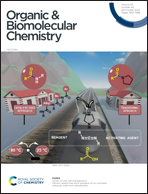Tryptophan association in water driven by charge-transfer interactions with electron-deficient aromatic haptens†‡
Abstract
The ability of a series of electron-deficient aromatic compounds to form charge-transfer complexes with tryptophan in water has been evaluated by X-ray diffraction studies, UV-vis spectra and NMR. As dinitrophenyl (DNP) ligands are well-known to generate antibody-mediated responses and the π–π stacking interactions with tryptophan residues of the antibody Fab fragment have been reported, most of the aromatic receptors studied here are nitro derivatives. Charge-transfer interactions between the rich indole ring of tryptophan and the electron-deficient aromatic receptors have been observed in the solid state, as four crystal structures of the complexes were obtained. The aromatic donor–acceptor interactions in solution were also verified by UV-vis and NMR spectroscopy. The association of the tripeptide Trp–Gly–Trp, a motif found in antigen Ag43, with the electron-deficient aromatic diimide was also studied by UV-vis and NMR spectroscopy. Our results show that these simple electron-deficient molecules could potentially behave as novel haptens and be incorporated in more elaborated drugs targeting protein–protein interactions, due to the synergistic effect of multiple non-covalent interactions.



 Please wait while we load your content...
Please wait while we load your content...